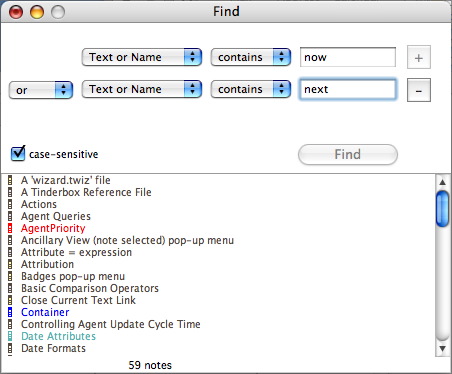|
This version is out of date, covering development from v4.6.0 to v4.7.1. It is maintained here only for inbound reference links from elsewhere. Jump to the current version of aTbRef. |
|
| A Tinderbox Reference File : Views : Minor views : Find view | aTbRef Site Map |
Find view |
The Find view allows you to enter a second query clause by pressing the "+" button. It can be thought of as a temporary agent, existing outside the TBX; its only function is to find information - the user than takes action on it via the UI. The case-sensitive option is saved as a document preference (but not an accessible Preference). Target pop-up. The choices are the same as for an agent. System attributes values cannot be queried via this dialog. The pop-up has the following values:
Match pop-up. The pop-up contains a list of operators as in the Create Agent dialog. Value. The value to be matched. To match non alphanumeric characters, e.g. a caret ^, you should escape them with a backslash: \^; to find a sequence of 2 carets use \^\^, etc. The rules are based on those required for use of Regular Expressions. As soon as the third character of a value is entered Tinderbox starts searching and listing matches automatically - you won't need to bother clicking the Find button. To search for a value of only 1 or 2 characters, type the value and click the Find button to initiate the search. + button. Click this to add a second query with target/match/value controls. - button. Removes the second query. case-sensitive. (default = ticked). If ticked comparisons are case sensitive. When you open the Find dialog, the initial value for case-sensitive is the value you set:
Case-sensitivity only applies to AttbributeName(pattern) arguments in the query. Find button. Find text based on the above settings [list of matching notes]. The bottom part of the pane shows notes matching the above criteria, sorted computer-style - i.e. with capital letters sorting first, then lower-case letters. Note colors are shown in the list. Display selected note in Outline view. Select a note and press Cmd+Opt+O (or Views menu, New Outline View) to see the selected note in an outline rooted at its parent. Notes in the list can be a target for links - this can save you scrolling or changing level a large outline or map view just to find the target for your link. Listed notes are rendered in their NameFont value's typeface (although not in their NameColor color, but using Color which make context in the following use of Outline view icons). The dialog uses icons similar to those in the Outline view. In particular, the icon indicates how much text the note or agent contains and how recently it has been modified, and whether it is a prototype. Note too, that map attributes and outline separators (both 'special' types of note) can be included in find results. If a note/agent is edited & closed or if it is renamed this is sensed and the list is updated - this is extremely useful when working through a list of corrections to a misspelt word. When the dialog list has focus the mouse wheel and/or arrow keys may be used to scroll the list. The Preferences, Map, Font size setting (Note label size) is also respected in this view - this is to allow for fonts that don't display well at the old hard-wired 12pt value used by this dialog. The view's list is drawn with the TBX's MapBackgroundColor. This can help when multiple TBXs are open, if each has a different MapBackgroundColor then it is clear to which TBX a Find dialog belongs. List item colors are darkened according to the (Map) Preference to Darken colors in charts and outlines. Unlike early versions the Find window no longer floats. When making an agent, if the Find window is open and has a query, the new agent’s query is taken from the Find window. If the Find window is not open, the new agent's query is empty as before. |
 |
| Up: Minor views | |
| Previous: Common Words view | Next: History view |

